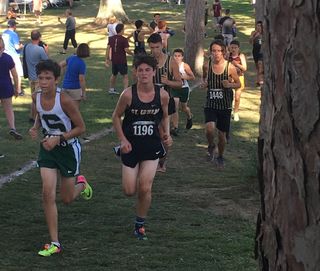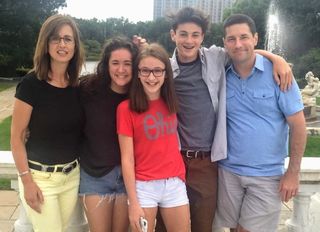A Family Full of Hope
Beacon Stories
18-year-old Marty Dubecky has a very unique decision to make. There are currently four gene therapy clinical trials for him to choose from to enroll in, which would have been unheard of 15 years ago when he was first diagnosed with XLRP.

The Dubecky family and their dog, Mullen, wearing their VisionWalk team t-shirts.
Greg and Paula Dubecky of Avon, Ohio, may have an amazing opportunity for their 18-year-old son to be enrolled in a gene therapy clinical trial for X-linked retinitis pigmentosa (XLRP). It is amazing because there are potentially four clinical trials for them to choose from, which would have been unheard of 15 years ago when their son, Marty, was first diagnosed at the age of three.
When he was a toddler, his parents noticed Marty had trouble seeing books that they read to him. Paula and her brother, Wally Anders, both have XLRP, so the family was no stranger to the disease and its symptoms. Since the diagnosis, the Dubeckys hit the ground running, doing everything in their power to stay informed and connected through the Foundation Fighting Blindness. They are leaders in the local Cleveland chapter and do extensive fundraising every year for VisionWalk, which they look forward to every spring; they said it feels like a second Christmas for their family.
Paula and her brother have served as an inspiration to Marty to not let his low vision keep him down. Wally lives a full life as an adventurer, a successful financial planner, and Paula says her brother is the most fearless person she has ever met. Paula herself is a force to be reckoned with, a devoted caregiver to Marty and his two sisters, organizing their day-to-day lives and helping them keep up with all their activities. She only recently stopped driving, which has been a challenge for her. However, they have a newly licensed teenager in the house who is more than happy to step in and help with that.

Marty running during a cross country meet.
“I was very fortunate that my vision loss progressed much slower than my brother’s. My own diagnosis never hit me hard until Marty’s, and mostly because he was so young.” Paula said. Not many women have vision loss from XLRP; they are usually unaffected carriers. However, thanks to advances in clinical care and genetic testing, more females are now being diagnosed with XLRP than 10–15 years ago.
Marty is a senior in high school, graduating this May, and is excited about his future. He is currently narrowing down his college choices to two universities in Ohio. He has a close-knit circle of friends from running cross country and track, which he competes in for his high school. “I did play a little bit of rugby in seventh and eighth grade, but it was a little tough because I had to keep track of a ball,” Marty said of his high school sports. “But for cross country and track, I just run. My vision doesn’t really pose a problem unless I let it.” Marty is modest about his success in running track and cross country.
Greg has kept a close watch on the scientific news and breakthroughs over the years and is well versed in the clinical trial pipeline. Currently, there are four gene therapy clinical trials for XLRP (RPGR mutations underway. Some of the trials – those sponsored by Applied Genetic Technologies Corporation (AGTC) and MeiraGTx/Janssen – have reported vision improvements and are in, or advancing toward, Phase 3. 4D Molecular Therapeutics recently launched a Phase 1/2 trial for its XLRP gene therapy.
Greg said one reason that he is anxious to get Marty into a trial is because of the timeline, “The longer Marty has to wait, the less vision he’s going to have, and the less opportunity for efficacy.” Paula agreed with her husband and added, “I feel good about putting him in a later phase trial, especially because he’s 18 and can better understand all of it. I’m not sure if he were very young how I would feel. I’m glad he can be part of the decision.”

The Dubecky family: (left to right) Paula, Clare, Annie, Marty, and Greg.
Marty’s feelings about participating in a trial are profoundly selfless for a young person. “It’d be great to fix my vision, obviously, but it’s not about me,” He said. “I don’t think one person is meant to put too much hope for themselves when entering a trial. I just want to be a part of the science that could possibly help other people and other kids like me who have RP. Of course, I’ll take the opportunity to be a part of that solution for them.”
We asked Marty what he would say to kids his age, or even younger, who are also on a similar journey as him, and he said, “I would have to tell them not to let it stop them. The choices are to either wallow in denial or look at what it has given you. My journey has made me humble and compassionate to other people. I’ve learned to have empathy for people that I meet because I don’t know what they could be going through.”
Marty and his family are continuing to stay positive as they weigh their options for a clinical trial. They are proof that the work we are doing at the Foundation is working, and one day we will have cures for blinding retinal diseases like XLRP. When that day comes, Marty can proudly say he was a part of making it happen.




